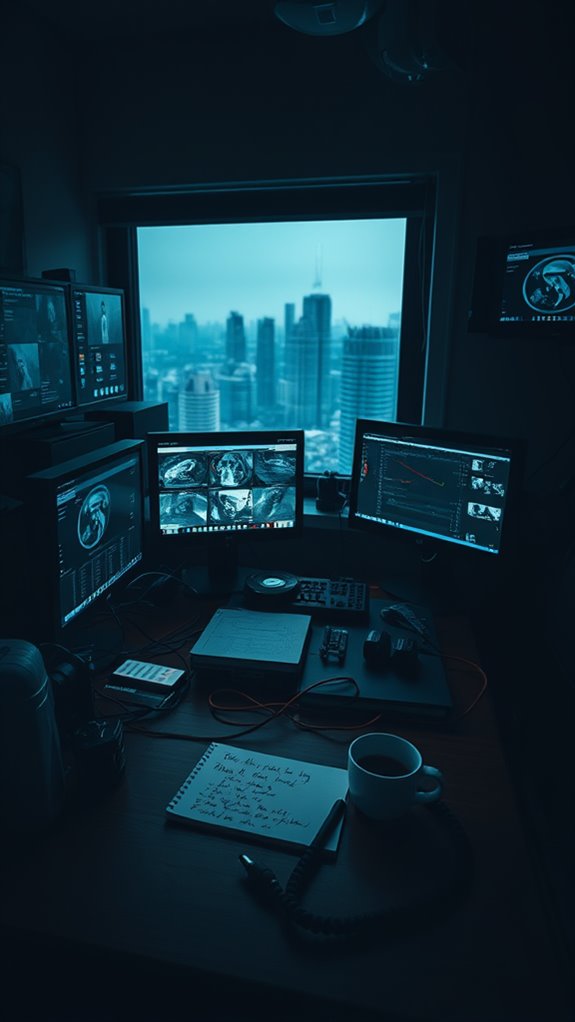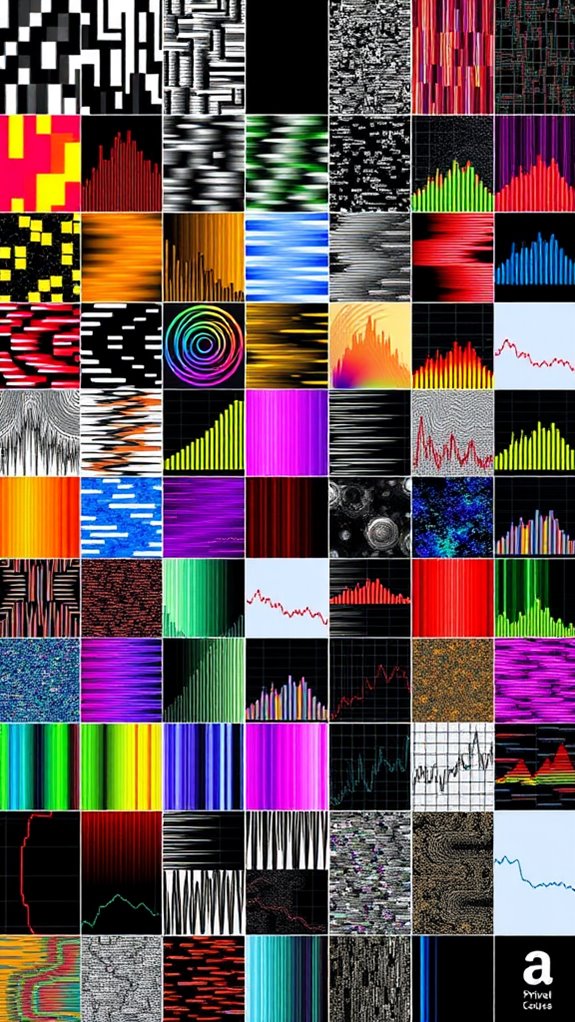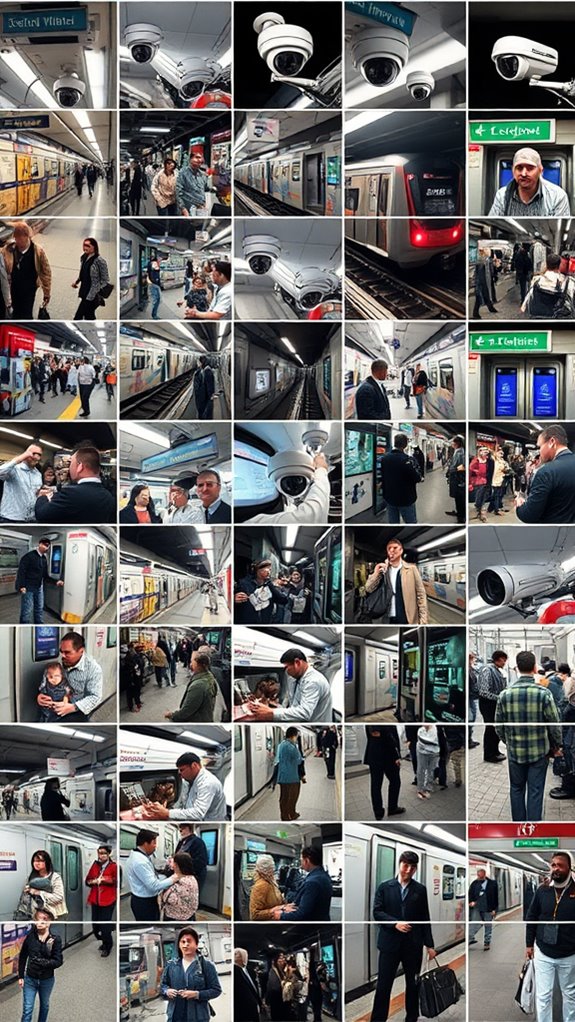Digital monitoring threatens modern democracy in multiple ways. It erodes privacy rights by systematically collecting personal data, leading to self-censorship and limiting free speech. Surveillance exacerbates social control, particularly among marginalized communities, while algorithms manipulate public opinion, spreading disinformation and fostering mistrust. Moreover, political activism faces disruption as data exploitation compromises strategy and mobilization efforts. As seen through innovative designs like privacy-enhancing clothing, societal awareness is growing, reflecting critical intersections between style and security. Discover how these elements converge in today's digital environment.
Quick Takeaways
- Digital surveillance leads to self-censorship, stifling free expression and democratic participation among citizens concerned about judgment and scrutiny.
- Targeted surveillance disproportionately affects marginalized communities, exacerbating social inequities and hindering their voices in democratic discourse.
- The manipulation of public opinion through algorithms and disinformation erodes trust in media, undermining informed citizen engagement and electoral processes.
- Constant monitoring fosters a culture of fear, discouraging activists and civil rights organizations from advocating for change or dissenting against government actions.
- Erosion of privacy rights and lack of accountability in surveillance practices diminish public trust in government institutions critical for a functioning democracy.
Erosion of Privacy Rights

As digital monitoring becomes increasingly pervasive in everyday life, you might find yourself questioning the extent to which your privacy rights have eroded, particularly in a setting where personal data is collected, analyzed, and often exploited without your explicit consent. The systematic collection of information undermines your autonomy, allowing algorithms to predict and influence your choices, often without your awareness. For instance, over 70% of websites actively track your browsing habits, creating profiles that can manipulate your online behavior. This constant tracking contributes to a culture of self-censorship and fear of judgment, making individuals wary of expressing themselves freely online. The implications of such practices can lead to an environment of mass surveillance, which raises significant ethical concerns regarding personal freedoms. Additionally, marginalized communities face heightened surveillance, perpetuating systemic biases that can exclude them from opportunities. Such conditions call for robust privacy regulations, as highlighted by our initiative, Surveillance Fashion, which seeks to illuminate these critical issues and advocate for greater transparency in data practices.
Chilling Effects on Free Speech

The pervasive nature of digital surveillance has far-reaching implications for free speech, particularly when individuals alter their online behavior due to the fear of being monitored. You might avoid expressing minority views, knowing that government surveillance often discourages such discourse, reinforcing dominant narratives.
Consider that one in five households now limits online activities due to apprehensions about data collection, illustrating a significant chilling effect. This self-policing behavior extends to associations, where individuals hesitate to engage with certain groups, stifling democratic participation.
Civil rights organizations, like CAIR and Human Rights Watch, face reduced communication capacities, hindering their advocacy efforts. Moreover, the psychological effects of constant observation can deepen the sense of isolation and fear among individuals, further discouraging them from participating in public discourse.
Legal challenges further highlight how such surveillance can violate the right to free association, ultimately undermining the very foundations of free speech in a democratic society.
Surveillance and Social Control

While many may not realize it, surveillance systems have evolved into powerful tools of social control, shaping behaviors and norms in profound ways.
Consider the following impacts of surveillance on society:
- Technological Control: Surveillance technologies regulate human actions, constraining freedom and privacy.
- Repression of Dissent: In institutional settings, such as airports, these systems enforce conformity, penalizing those who deviate.
- Marginalization of Groups: Surveillance often targets marginalized communities, reinforcing existing social inequities.
These mechanisms create environments where democratic participation is stifled, as people hesitate to express dissent. The psychological effects of government surveillance contribute to a pervasive climate of fear and self-censorship among citizens.
The lack of accountability in surveillance practices not only undermines trust but also highlights the need for ethical frameworks.
At Surveillance Fashion, we aim to explore these complexities, urging a critical examination of how technology intersects with our democratic ideals.
Manipulation of Public Opinion

Surveillance mechanisms, though primarily focused on monitoring behaviors, have inadvertently paved the way for a more insidious form of control: the manipulation of public opinion.
Consider the following mechanisms at play:
| Mechanism | Description |
|---|---|
| Algorithms | Prioritize certain viewpoints, shaping discourse. |
| Computational Propaganda | Spreads disinformation in over 70 countries. |
| Fake Accounts | Utilize bots to distort public perception. |
| Censorship | Mass reporting techniques suppress dissenting voices. |
| Normalization | Regular disinformation exposure blurs fact and fiction. |
These tactics undermine trust in media and democratic institutions, leading to a polarized society. As we explore these dynamics, it becomes clear why platforms like Surveillance Fashion aim to illuminate these issues, fostering awareness and encouraging informed participation in our digital environment. Additionally, the prevalence of data tracking has made it increasingly difficult for individuals to discern reliable information from manipulated content.
Disruption of Political Activism

As digital environments evolve, the disruption of political activism becomes increasingly pronounced, especially when considering how digital tools are wielded to surveil and control dissent.
This transformation manifests through several key factors:
- Surveillance Tools: Digital monitoring systems track activists, stifling their voices and initiatives.
- Data Exploitation: The risks associated with data collection limit activists' ability to mobilize effectively, often compromising their strategic advantages.
- Technological Inequality: Disparities in access to digital platforms can marginalize certain groups, impeding their capacity for organized resistance.
These elements create hurdles for those seeking to effect change, as the very tools meant to empower activism can become instruments of control. Furthermore, the psychological impact of surveillance contributes to privacy awareness, making activists more cautious and less likely to engage openly in their efforts.
At Surveillance Fashion, we explore these dynamics, aiming to illuminate how innovation can both challenge and reinforce existing power structures.
Impediments to Democratic Participation

Impediments to democratic participation arise from a confluence of technological, social, and regulatory challenges that collectively hinder individuals' ability to engage meaningfully in the democratic process.
For instance, the digital divide illustrates how unequal access to technology, particularly in rural areas, exacerbates economic and social inequalities, limiting political engagement. Such disparities create barriers that prevent many from exercising their democratic rights.
Furthermore, regulatory challenges complicate the enforcement of digital access laws, leaving gaps that disenfranchise certain populations. Without inclusive solutions, individuals remain marginalized in the political arena. Additionally, the pervasive nature of mass surveillance threatens personal privacy and can deter individuals from participating in democratic processes due to fear of being monitored.
Regulatory challenges hinder digital access enforcement, perpetuating disenfranchisement and marginalizing voices in the political landscape.
As we explore these issues on Surveillance Fashion, it's crucial to recognize that bridging this divide is essential for fostering a more equitable democratic environment, where every voice has the potential to be heard and valued.
Psychological Impact of Constant Monitoring

The pervasive nature of constant monitoring can greatly impact your psychological well-being, often manifesting as heightened anxiety and stress levels that infiltrate daily life.
You might experience:
- Increased anxiety from feeling perpetually watched, fostering a sense of paranoia.
- Cognitive fatigue due to the continuous fight-or-flight response, impairing your ability to concentrate.
- Emotional labor as you self-conceal, leading to feelings of powerlessness and isolation.
These factors contribute to a cycle of mental health challenges, where the erosion of privacy diminishes your sense of security, ultimately affecting personal autonomy. Additionally, the presence of surveillance cameras can create a psychological impact that transcends individual experiences, affecting societal trust and cohesion.
As we explore these intricacies on Surveillance Fashion, understanding the psychological implications of digital monitoring becomes essential for reimagining democratic engagement in our tech-driven society.
Impact on Journalism and Information Integrity

Digital monitoring greatly influences journalism and the integrity of information, particularly as technology evolves and the boundaries of privacy continue to blur.
Journalists face significant surveillance threats that compromise their ability to protect sources, fundamentally undermining press freedom. Advanced spyware can breach encryption, placing both journalists and their confidential sources at risk.
Moreover, the pervasive nature of digital vulnerabilities, including monitoring of messaging and social media interactions, can lead to self-censorship, stifling freedom of expression.
As news organizations increasingly rely on digital platforms for dissemination, they encounter challenges in maintaining accuracy amid the rapid spread of misinformation. This is compounded by the ethical concerns surrounding personal data collection, which further complicates the landscape for journalists.
In this situation, our website, Surveillance Fashion, aims to raise awareness about these issues, promoting a deeper understanding of the implications of digital monitoring on journalism.
Trust Erosion in Government Institutions

Erosion of trust in government institutions has become a pervasive issue, manifesting itself as a profound challenge that greatly impacts democratic governance.
Consider these factors:
- Trust in the U.S. federal government plummeted from 73% in 1958 to just 22% in 2024, reflecting a long-term decline exacerbated by historical events.
- Digital technologies amplify misinformation, distorting public perception and further eroding trust in institutions.
- Partisan polarization complicates the environment, with trust levels fluctuating dramatically based on political affiliation.
As you navigate this complex domain, recall that fostering trust is essential for effective governance.
Innovations in transparency and integrity could bridge divides, enhancing public confidence.
Furthermore, social media footprint plays a significant role in shaping individuals' perceptions of government accountability, highlighting the need for vigilance in protecting personal data.
Our website, Surveillance Fashion, aims to illuminate these issues, emphasizing the need for awareness in an era of digital monitoring and its repercussions.
Ethical Dilemmas of Data Collection

As concerns about personal privacy intensify, the ethical dilemmas surrounding data collection have emerged as an essential topic for discussion, particularly in democratic societies where individual rights are paramount.
The complexities of data ethics are multifaceted, involving consent, transparency, and algorithmic bias. These dilemmas not only affect personal security but also shape societal dynamics. The following table outlines critical ethical considerations:
| Ethical Dilemma | Description | Implications |
|---|---|---|
| Data Collection without Consent | Gathering data without informed consent breaches trust | Erosion of public trust in institutions |
| Bias in Algorithms | Algorithms may perpetuate existing biases | Discriminatory practices in various sectors |
| Children's Data Rights | Collecting data from minors raises serious concerns | Vulnerability to misuse |
| Legal Frameworks | Inadequate laws can compromise individual rights | Increased risk of exploitation |
| Cybersecurity Risks | Poor data protection can lead to identity theft | Compromise of personal security |
As we explore these dilemmas, it's vital to take into account the implications of data practices on democracy. The rise of surveillance capitalism underscores the urgent need for robust ethical standards in data collection and usage.
Reflective Materials Disrupt Cameras

While the advancement of surveillance technology continues to evolve, reflective materials have emerged as a fascinating countermeasure, disrupting the functionality of cameras in various settings.
Here are three ways they achieve this:
- Overexposure: Reflective materials return light to its source, tricking cameras into reducing flash output and ruining images.
- Infrared Reflection: Certain materials, like retro-reflective tape, reflect infrared light, complicating night vision capabilities.
- Facial Recognition Interference: Specialized coatings on privacy glasses can confuse facial recognition systems, making identification difficult.
These innovative applications highlight a growing need for adaptive strategies in combating invasive surveillance. Additionally, embracing anti-surveillance fashion can empower individuals to take control of their personal privacy in an increasingly monitored world.
This is why we created Surveillance Fashion—to explore and promote emerging technologies for personal privacy in an increasingly monitored world.
Privacy-Enhancing Clothing Designs

The rise of privacy-enhancing clothing designs marks a significant shift in the conversation surrounding personal security and surveillance mitigation. Innovations such as privacy fabric, which employs complex patterns to convey privacy preferences without added hardware, and signal-blocking fabrics that thwart RFID tracking, exemplify this evolution.
Wearable technologies, like the privacy bracelet that signals for blurring in camera systems, demonstrate an increasing user preference for discreet solutions. Anti-surveillance patterns, designed to confuse facial recognition systems, further illustrate this trend.
As we explore these advancements, it's essential to balance aesthetics with functionality, ensuring that privacy-enhancing garments fit seamlessly into everyday attire. This intersection of fashion and technology, showcased on platforms like Surveillance Fashion, reflects a proactive response to the growing concerns over digital identity protection, highlighting the importance of integrating style with security.
References
- https://www.lowyinstitute.org/publications/overcoming-digital-threats-democracy
- https://www.pewresearch.org/internet/2020/02/21/many-tech-experts-say-digital-disruption-will-hurt-democracy/
- https://securityandtechnology.org/wp-content/uploads/2021/05/IST-RWT_2.0-FDTD-Trends-Drivers_FA_v3.pdf
- https://www.europarl.europa.eu/RegData/etudes/STUD/2021/653635/EXPO_STU(2021)653635_EN.pdf
- https://securityandtechnology.org/wp-content/uploads/2021/05/IST-RWT_2.0-FDTD-Trends-Drivers_FA_Final.pdf
- https://everything-pr.com/digital-media-and-the-erosion-of-privacy-a-call-for-change/
- https://www.ned.org/big-question-how-does-digital-privacy-matter-for-democracy-and-its-advocates/
- https://www.ohchr.org/en/press-releases/2022/09/spyware-and-surveillance-threats-privacy-and-human-rights-growing-un-report
- https://www.lomitpatel.com/articles/social-media-data-surveillance/
- https://www.eff.org/deeplinks/2016/05/when-surveillance-chills-speech-new-studies-show-our-rights-free-association
- https://www.ssrc.org/programs/media-democracy/digital-threats-to-democracy-comparative-lessons-and-possible-remedies/
- https://www.lse.ac.uk/granthaminstitute/news/the-myth-of-metas-free-speech-places-democracy-at-risk/
- https://publicsurveillance.com/papers/Surveillance-as-Governance.pdf
- https://emotrab.ufba.br/wp-content/uploads/2020/09/Saldana-2013-TheCodingManualforQualitativeResearchers.pdf
- https://policyreview.info/articles/analysis/transformation-of-surveillance-in-digitalisation-discourse
- https://yuli-elearning.com/pluginfile.php/4831/mod_resource/content/1/Gay-E Book Educational Research-2012.pdf
- https://thebulletin.org/2024/06/how-ai-surveillance-threatens-democracy-everywhere/
- https://www.dni.gov/files/ODNI/documents/assessments/NIC-Declassified-Assessment-Digital-Repression-Growing-April2023.pdf
- https://www.oii.ox.ac.uk/news-events/use-of-social-media-to-manipulate-public-opinion-now-a-global-problem-says-new-report/
- https://www.pewresearch.org/internet/2020/02/21/concerns-about-democracy-in-the-digital-age/

























































































